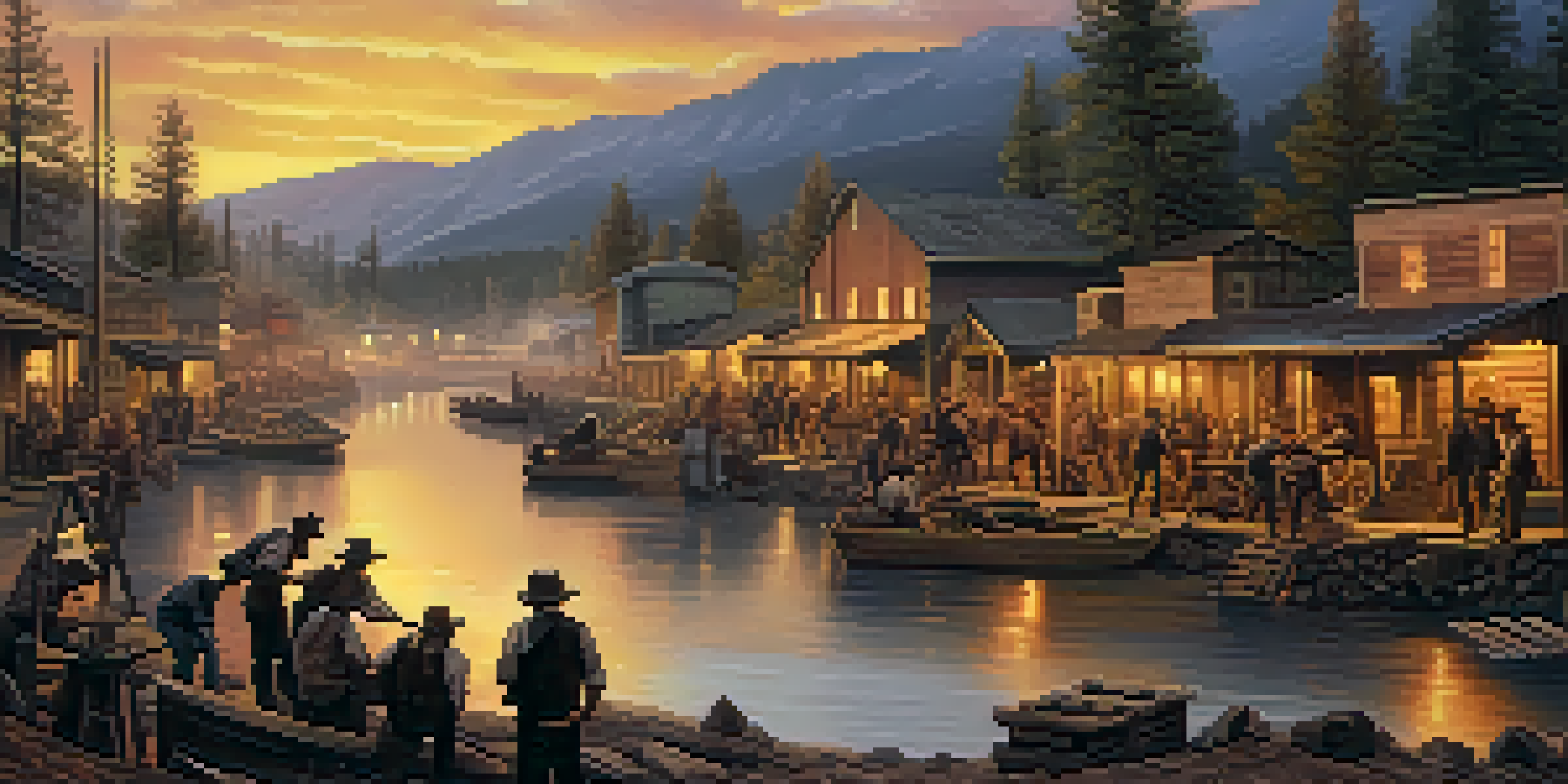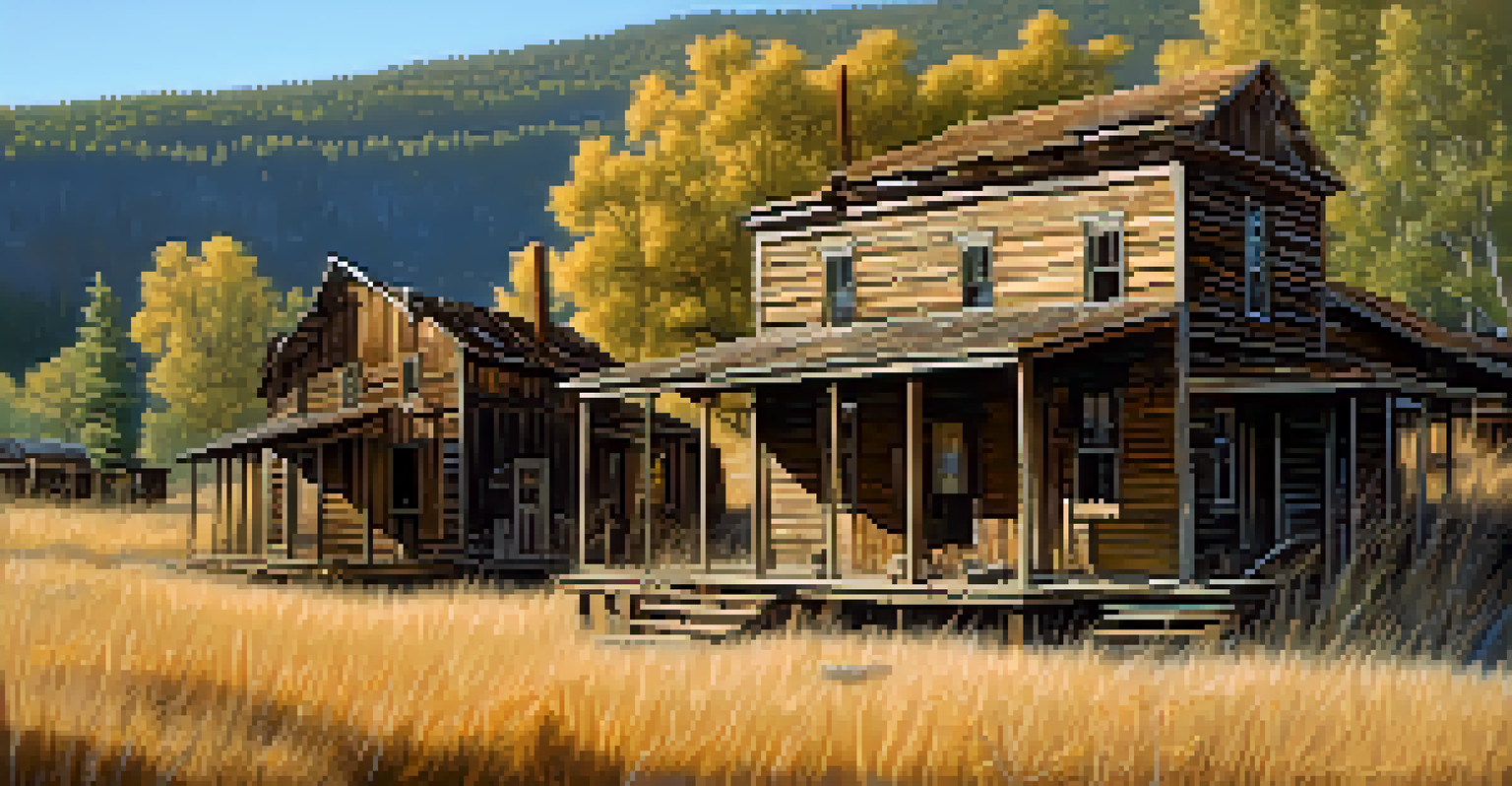The Gold Rush Towns: A Journey Through California's Past

The Spark that Ignited the Gold Rush
The California Gold Rush began in 1848 when gold was discovered at Sutter's Mill. This monumental event attracted thousands of hopeful prospectors, known as '49ers', who flocked to California in search of fortune. The promise of wealth transformed the state, leading to a massive population surge and the rapid development of towns.
The Gold Rush is a symbol of hope and ambition, a testament to the human spirit's relentless pursuit of opportunity.
As word spread, miners traveled from far and wide, often facing treacherous conditions. Many came with dreams of striking it rich, but few found lasting success. The allure of gold, however, created a vibrant community where diverse cultures mingled, showcasing resilience and ambition.
This initial rush laid the groundwork for California’s transformation into a state with a rich history. The legacy of these early settlers can still be felt today in the preserved towns and stories that echo through time.
Life in the Gold Rush Towns
Life in the Gold Rush towns was a mix of excitement and hardship. Miners lived in makeshift tents and shanties, often battling harsh weather and scarce resources. Despite the challenges, these towns thrived with saloons, general stores, and even schools, reflecting a burgeoning sense of community.

Everyday life revolved around the search for gold, but social activities also flourished. Dance halls and gambling houses offered a much-needed escape from the rigors of mining life. The towns became melting pots of cultures, bringing together people from various backgrounds and creating a unique blend of traditions.
Gold Rush Transformed California
The California Gold Rush, ignited by the discovery of gold in 1848, led to a massive population surge and the rapid development of towns.
This vibrant atmosphere was both chaotic and exhilarating, with the constant promise of wealth just beneath the surface. Each town had its own personality, shaped by the dreams and struggles of those who called it home.
Famous Gold Rush Towns to Explore
Some towns stand out as icons of the Gold Rush era, each with its own stories to tell. For example, Nevada City became a bustling center for miners and merchants, showcasing beautiful Victorian architecture that still attracts visitors today. Another notable town, Grass Valley, was known for its rich gold deposits and historic mining operations.
The Gold Rush was not just about riches; it was about the dreams and aspirations that shaped a nation.
In contrast, the ghost town of Bodie offers a glimpse into the past, preserved in a state of 'arrested decay.' Visitors can wander through the remnants of buildings and streets, imagining the vibrant life that once filled the town. Each of these locations reveals a different facet of the Gold Rush experience.
Exploring these historic towns provides a tangible connection to California's past, allowing visitors to step back in time and appreciate the resilience of those who sought their fortunes.
The Role of Women in the Gold Rush
While men often dominated the mining scene, women played a crucial role in shaping Gold Rush communities. Many women moved to California seeking adventure, economic opportunity, or to join family members. They established businesses, ran boarding houses, and provided essential services that supported miners and their families.
Women like Clara Brown, an African American entrepreneur, became influential figures in their towns, demonstrating that the Gold Rush was not solely a male pursuit. Their contributions extended beyond economic endeavors; they fostered social networks and created spaces for community support.
Women Shaped Gold Rush Communities
Women played a vital role in Gold Rush towns by establishing businesses and providing essential services, highlighting their contributions beyond the mining industry.
Understanding the role of women during this era highlights the diverse experiences of those who lived through the Gold Rush. Their stories remind us that the pursuit of fortune was a shared journey, filled with both challenges and triumphs.
Cultural Impact of the Gold Rush
The Gold Rush had a profound cultural impact, not only on California but also across the United States. It spurred a wave of westward expansion, encouraging many to seek new opportunities beyond the Mississippi River. This migration influenced American culture, fostering ideals of adventure and independence.
Moreover, the Gold Rush brought diverse cultures together, particularly from Asia and Europe. Immigrants contributed to the mining workforce and established communities, enriching California's cultural tapestry. These interactions laid the groundwork for the multicultural society we see today.
In literature and folklore, the Gold Rush has inspired countless stories, shaping the American narrative. The tales of fortune seekers and daring exploits continue to captivate audiences, reminding us of the spirit of exploration that defined this era.
Environmental Consequences of Gold Mining
The Gold Rush wasn’t just a human endeavor; it had significant environmental consequences that ripple through history. Mining techniques, such as hydraulic mining, altered landscapes, disrupted ecosystems, and led to soil erosion. Rivers once teeming with life suffered from sedimentation and pollution, affecting both wildlife and local communities.
As miners sought to extract gold, they often overlooked the long-term impact on the land. The quest for wealth resulted in deforestation and habitat destruction, raising questions about sustainability that are still relevant today. This history serves as a reminder of the delicate balance between human ambition and environmental stewardship.
Environmental Impact of Mining
The Gold Rush significantly altered landscapes and ecosystems, raising enduring questions about the balance between ambition and environmental stewardship.
Modern discussions about responsible mining practices can trace their roots back to these historical events. Understanding the environmental legacy of the Gold Rush encourages a more mindful approach to resource extraction today.
Preserving Gold Rush Heritage
Today, many Gold Rush towns are preserved as historic sites, attracting visitors eager to learn about this fascinating chapter in American history. Organizations and local governments work tirelessly to maintain these sites, offering guided tours, educational programs, and reenactments that bring the past to life. These efforts ensure that the stories of the Gold Rush era continue to resonate with future generations.
Visitors can explore museums, partake in gold panning, and experience the charm of the old towns. Events like Gold Rush Days celebrate this heritage, inviting families to step into the shoes of miners and settlers. Such experiences foster appreciation for the resilience and creativity of those who came before us.

By preserving these sites, we honor the legacy of the Gold Rush while also reflecting on the lessons learned. The stories of ambition, community, and consequence serve as powerful reminders of our shared history.